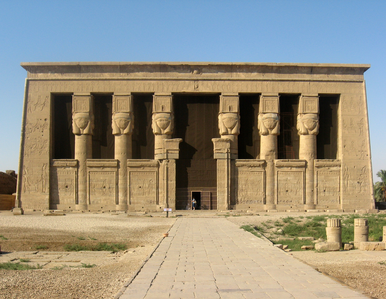 Temple of Hathor
Temple of Hathor Dendera Temple complex, (Ancient Egyptian: Iunet or Tantere; the 19th-century English spelling in most sources, including Belzoni, was Tentyra) is located about 2.5 km south-east of Dendera, Egypt.
It is one of the best preserved temples in Egypt. The area was used as the sixth Nome of Upper Egypt, south of Abydos.
The whole complex covers some 40,000 square meters and is surrounded by a hefty mud brick enclosed wall. Dendera was a site for chapels or shrines from the beginning of history of ancient Egypt.
It seems that pharaoh Pepi I (ca. 2250 BC) built on this site and evidence exists of a temple in the eighteenth dynasty (ca 1500 BC). But the earliest extant building in the compound today is the Mammisi raised by Nectanebo II – last of the native pharaohs (360–343 BC).
It is one of the best preserved temples in Egypt. The area was used as the sixth Nome of Upper Egypt, south of Abydos.
The whole complex covers some 40,000 square meters and is surrounded by a hefty mud brick enclosed wall. Dendera was a site for chapels or shrines from the beginning of history of ancient Egypt.
It seems that pharaoh Pepi I (ca. 2250 BC) built on this site and evidence exists of a temple in the eighteenth dynasty (ca 1500 BC). But the earliest extant building in the compound today is the Mammisi raised by Nectanebo II – last of the native pharaohs (360–343 BC).
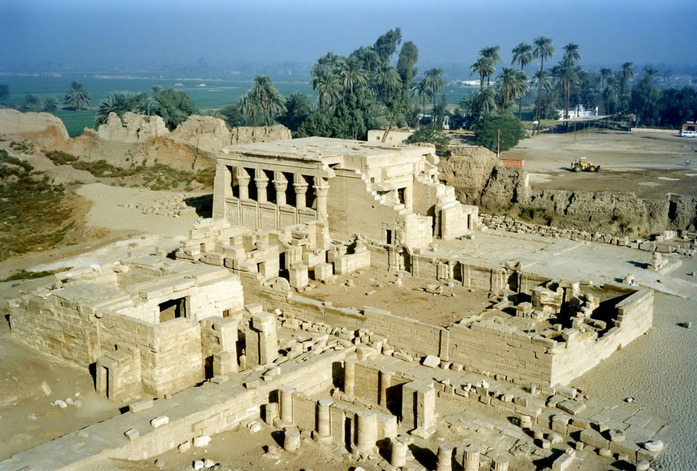 Dendera Temple Complex
Dendera Temple Complex The features in the complex include
- Hathor temple (the main temple),
- Temple of the birth of Isis,
- Sacred Lake,
- Sanatorium,
- Mammisi of Nectanebo II,
- Christian Basilica,
- Roman Mammisi,
- a Bark shine,
- Gateways of Domitian & Trajan and
- the Roman Kiosk.
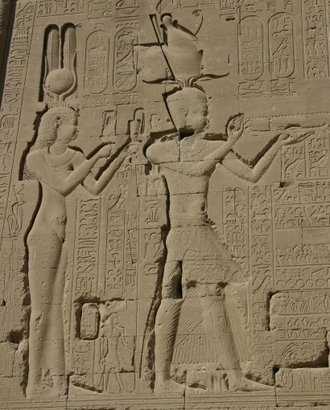 Reliefs of Cleopatra VII and her son by Julius Caesar
Reliefs of Cleopatra VII and her son by Julius Caesar The all overshadowing building in the Complex is the main temple, namely Hathor temple (historically, called the Temple of Tentyra).
The temple has been modified on the same site starting as far back as the Middle Kingdom, and continuing right up until the time of the Roman emperor Trajan.
The existing structure was built no later than the late Ptolemaic period. The temple, dedicated to Hathor, is one of the best preserved temples in all Egypt.
Subsequent additions were added in Roman times.
The temple has been modified on the same site starting as far back as the Middle Kingdom, and continuing right up until the time of the Roman emperor Trajan.
The existing structure was built no later than the late Ptolemaic period. The temple, dedicated to Hathor, is one of the best preserved temples in all Egypt.
Subsequent additions were added in Roman times.
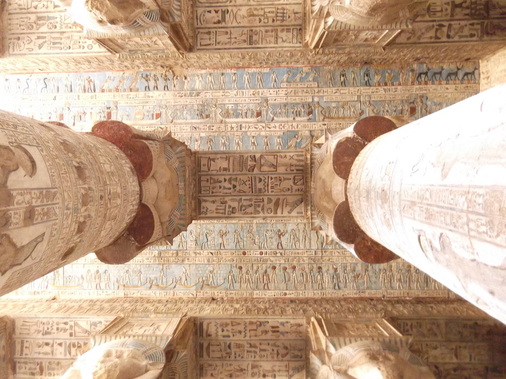 Ceiling of the Temple
Ceiling of the Temple Depictions of Cleopatra VI which appear on temple walls are good examples Ptolemaic Egyptian art. One depicts Cleopatra and her son, Caesarion. On the rear of the temple exterior is a carving of Cleopatra VII Philopator and her son, Ptolemy XV Philopator Philometor Caesar, fathered by Julius Caesar.
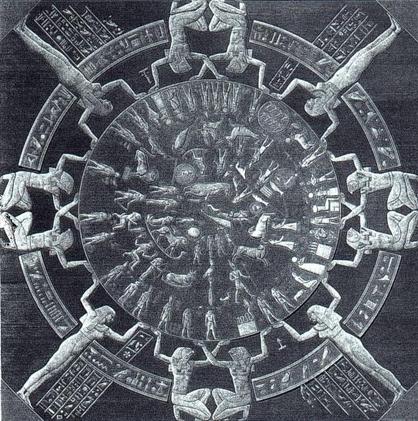 Dendera Zodiac
Dendera Zodiac The sculptured Dendera zodiac (or Denderah zodiac) is a widely known relief found in a late Greco-Roman temple, containing images of Taurus (the bull) and the Libra (the balance).
A sketch was made of it during the Napoleonic campaign in Egypt. and in 1820 it was removed from the ceiling and is now in the Louvre.
Champollion's guess that it was Ptolemaic proved correct and Egyptologists now date it to the first century BC, the time when Cleopatra would have studied magic and astrology under the tutelage of the priests of Isis and Osiris.
A sketch was made of it during the Napoleonic campaign in Egypt. and in 1820 it was removed from the ceiling and is now in the Louvre.
Champollion's guess that it was Ptolemaic proved correct and Egyptologists now date it to the first century BC, the time when Cleopatra would have studied magic and astrology under the tutelage of the priests of Isis and Osiris.
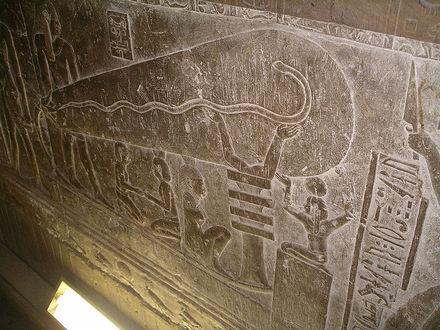 The Dendera Light
The Dendera Light Hathor Temple has a relief sometimes known as the Dendera Light because of a controversial fringe thesis about its nature.
The Dendera light images comprise five stone reliefs (two of which contain a pair of what fringe authors refer to as lights) in the Hathor temple at the Dendera Temple complex located in Egypt.
The view of Egyptologists is that the relief is a mythological depiction of a djed pillar and a lotus flower, spawning a snake within, representing aspects of Egyptian mythology.
In contrast to this interpretation, there is a fringe science suggestion that it is actually a representation of an Ancient Egyptian lightbulb. These depictions are much more related to the magic rituals of the priests of Isis and Osiris of which Cleopatra was an initiate, than of any ancient alien or super civilization technology. Because of Cleopatra's powerful magical worldview--inculcated in her from birth by the priests--it is no wonder that she thought she could command her armies from a darkened room, by communing in a quartz mirror. The Sphere of Destiny in the Temple of Isis, now underwater in the Harbor of Alexandria, was the room in which the mystical glass known as the Eye of Cleopatra was harbored.
The Dendera light images comprise five stone reliefs (two of which contain a pair of what fringe authors refer to as lights) in the Hathor temple at the Dendera Temple complex located in Egypt.
The view of Egyptologists is that the relief is a mythological depiction of a djed pillar and a lotus flower, spawning a snake within, representing aspects of Egyptian mythology.
In contrast to this interpretation, there is a fringe science suggestion that it is actually a representation of an Ancient Egyptian lightbulb. These depictions are much more related to the magic rituals of the priests of Isis and Osiris of which Cleopatra was an initiate, than of any ancient alien or super civilization technology. Because of Cleopatra's powerful magical worldview--inculcated in her from birth by the priests--it is no wonder that she thought she could command her armies from a darkened room, by communing in a quartz mirror. The Sphere of Destiny in the Temple of Isis, now underwater in the Harbor of Alexandria, was the room in which the mystical glass known as the Eye of Cleopatra was harbored.
 RSS Feed
RSS Feed